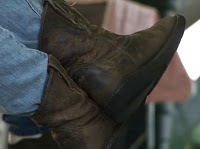Using tight shots as illustrations, avoiding unnecessary moves
 Thursday, June 18, 2009
Thursday, June 18, 2009 I've written in the past about how I dislike wide-shots. Well it wont come as surprise to those of you who read that post that I enjoy using tight or close-up shots.
While a wide variety of shots is usually required in a news piece, most times a package can be made significantly richer with the incorporation of close-ups whenever possible.
I've watched many news packages on television - mostly, it has to be said, on local shows - that use virtually no tight-shots at all. Such shots often take time and patience to construct and frame properly which may be one reason why they're not used.
I'm going to use a piece that I just produced for AFP Television on cowboy churches in North America. AFP's usage policy does not allow me to embed the video here, so to see the piece you will need to click here and it will take you to the relevant YouTube page.

You'll notice that the story starts with a mid-shot rather than a typical wide-shot. The barn was nothing to look at and would have made a really tedious opening picture. But immediately after the opening shot, I get into the tight-shots - firstly of the preacher himself, then his congregation.
Throughout the piece, I use tight-shots. Other than a handful of mid-shots, most every other picture is a close-up. When a story is rich in color, which this one is, tight-shots take the viewer much closer to what you're trying to show. It adds character to the story. People's faces are expressive - you get a much better feeling for who the people are that you're shooting than you would if you simply used a series of wide-shots. I think it makes it personal, in a good way.
Here are a few keys to shooting and using tight shots effectively:
1) Make sure you have something to show. Random close-ups of not very much wont work. Close-up shots for the sake of it are silly. Use them when you want to illustrate something, like the expression on someone's face, or what they're wearing. Here you will see I used a tight-shot of a pair of boots to illustrate the Western clothing that people had on.

2) Frame it up correctly. Because you are using the whole screen, make sure you're thinking about the dimensions of your finished project. If you're shooting in 16:9 but producing a 4:3 project (as was the case with this story), be sure to shoot 4:3 safe when doing tight-shots, otherwise part of your subject will be lost.
Also, be creative with your framing. Don't always assume you have to shoot the subject of the tight-shot so that it appears in the middle of the screen. Use your judgement about what looks good. You'll see that most of the face close-ups that I use are on either the right or left third of the screen. Make sure you use a mixture of left and right so you can cut them together easily during editing and avoid jump cuts.
Get imaginative with your framing and you'll soon figure out what you like.
3) Use a shallow depth of field. You're using a tight shot to show something to the viewer. Don't distract the viewer with lots of surroundings. Open the iris fully and adjust light using filters, shutter speed and gain. If your shots are a little over-exposed due to the wide iris setting, you can fairly easily adjust during editing. Blurring the background really helps the subject of the shot to pop out of the screen.
4) Tighten up your interviews. You'll see I use fairly tight framing for the interview subjects too. This is a personal preference of mine, but I just really don't want to see a whole lot of the person speaking, except their face - the bit that the noise comes out of! Generally, wide interview shots look messy. But if you do go tight like I do and you're shooting your own interviews, make sure you keep checking the viewfinder - your interviewee may only move a couple of inches, but that's enough to completely screw up your framing.
If you watched this piece closely, you might have noticed that I didn't use any moves such as pans, pushes and pulls. I don't mind moves if they actually illustrate something or are used to break up the monotony of really boring b-roll. But just using moves for the heck of it is dumb. In my humble judgement, this piece just didn't need it. You have to ask yourself; 'what am I pulling out to reveal?' or 'when I pan over there, what am I panning to?' Don't just use a move for no reason.
There are lots of ways to bring what you see first hand to the viewer as effectively as you can, but the tight-shot is one of my favorite tools. If you're a journalist, you're a story teller, so tell a story. If you're a videographer too, you get to use the power of pictures to tell a story. What could be better than that?
 Steve Mort |
Steve Mort |  Post a Comment |
Post a Comment | 
Reader Comments